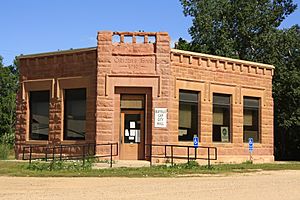Buffalo Gap, South Dakota facts for kids
Quick facts for kids
Buffalo Gap, South Dakota
pté tȟathíyopa otȟúŋwahe
|
|
|---|---|

Buffalo Gap Town Hall, July 2011
|
|

Location in Custer County and the state of South Dakota
|
|
| Country | United States |
| State | South Dakota |
| County | Custer |
| Area | |
| • Total | 0.31 sq mi (0.79 km2) |
| • Land | 0.31 sq mi (0.79 km2) |
| • Water | 0.00 sq mi (0.00 km2) |
| Elevation | 3,268 ft (996 m) |
| Population
(2020)
|
|
| • Total | 131 |
| • Density | 428.10/sq mi (165.50/km2) |
| Time zone | UTC-7 (MST) |
| • Summer (DST) | UTC-6 (MDT) |
| Zip Code |
57722
|
| Area code(s) | 605 |
| FIPS code | 46-08340 |
| GNIS feature ID | 1267303 |
Buffalo Gap (Lakota: pté tȟathíyopa otȟúŋwahe; "buffalo gap village") is a town in Custer County, South Dakota, United States. The population was 131 at the 2020 census.
History
A very old western South Dakota town, Buffalo Gap was founded in 1877. By 1885, it was a railroad spur for the Fremont, Elkhorn and Missouri Valley Railroad line, with more than 1,200 residents. Today, the town has about 180 residents.
In its early years it was one of the largest towns in South Dakota, but it received the same fate as many other towns of that era. A resident's cow kicked over a lantern and it burned the town to the ground, as happened with the Great Chicago Fire and many others. The town never fully recovered and was never rebuilt to its former grandeur.
The name comes from a gap to the west of town that sheltered buffalo herds in earlier times. Although Buffalo Gap burned down several times, there are a number of historic buildings still standing. Located on State Hwy 79 between Hermosa and Hot Springs, Buffalo Gap intersects with County Road 656, an “off the beaten path” that travelers can take into the Buffalo Gap National Grasslands, Badlands National Park and the Pine Ridge Indian Reservation
Part of the action of the French book La Brèche aux buffles takes place in Buffalo Gap.
Geography
According to the United States Census Bureau, the town has a total area of 0.31 square miles (0.80 km2), all land.
Demographics
| Historical population | |||
|---|---|---|---|
| Census | Pop. | %± | |
| 1910 | 280 | — | |
| 1920 | 132 | −52.9% | |
| 1930 | 183 | 38.6% | |
| 1940 | 182 | −0.5% | |
| 1950 | 186 | 2.2% | |
| 1960 | 194 | 4.3% | |
| 1970 | 155 | −20.1% | |
| 1980 | 186 | 20.0% | |
| 1990 | 173 | −7.0% | |
| 2000 | 164 | −5.2% | |
| 2010 | 126 | −23.2% | |
| 2020 | 131 | 4.0% | |
| U.S. Decennial Census | |||
2010 census
As of the census of 2010, there were 126 people, 66 households, and 32 families living in the town. The population density was 406.5 inhabitants per square mile (157.0/km2). There were 85 housing units at an average density of 274.2 per square mile (105.9/km2). The racial makeup of the town was 91.3% White, 7.1% Native American, 0.8% from other races, and 0.8% from two or more races. Hispanic or Latino of any race were 0.8% of the population.
There were 66 households, of which 16.7% had children under the age of 18 living with them, 39.4% were married couples living together, 3.0% had a female householder with no husband present, 6.1% had a male householder with no wife present, and 51.5% were non-families. 43.9% of all households were made up of individuals, and 19.7% had someone living alone who was 65 years of age or older. The average household size was 1.91 and the average family size was 2.63.
The median age in the town was 53 years. 16.7% of residents were under the age of 18; 2.5% were between the ages of 18 and 24; 15.2% were from 25 to 44; 41.2% were from 45 to 64; and 24.6% were 65 years of age or older. The gender makeup of the town was 57.1% male and 42.9% female.
Notable person
- Rex Putnam, Oregon Superintendent of Public Instruction
See also
 In Spanish: Buffalo Gap (Dakota del Sur) para niños
In Spanish: Buffalo Gap (Dakota del Sur) para niños

